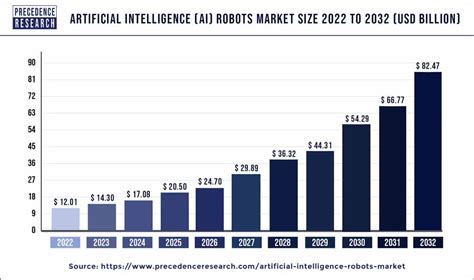Overview
The AI robot pet industry is experiencing a surge in popularity, driven by advancements in artificial intelligence (AI) and a growing demand for companionship and emotional support. These pets offer unique advantages over traditional living creatures, making them an attractive option for people of all ages and lifestyles.

Recent industry reports estimate that the global AI robot pet market is expected to exceed $30 billion by 2025, growing at a CAGR of over 30%. This growth is attributed to factors such as increasing disposable income, rising urbanization, and the desire for personalized experiences.
Market Segmentation
The AI robot pet market can be segmented into various categories based on:
- Pet Type: Dogs, cats, fish, birds, and other animals
- Function: Companionship, education, therapeutic, entertainment
- Price: Low-end, mid-range, high-end
- Target Audience: Children, adults, seniors, pet lovers
Key Players
Several companies are leading the AI robot pet market, including:
- Sony
- Hasbro
- Mattel
- Anki
- WowWee
These companies are investing heavily in research and development to create innovative products that meet the evolving needs of consumers.
Market Dynamics
The AI robot pet industry is driven by several key factors, including:
- Technological Advancements: AI advancements enable robots to exhibit realistic behaviors and respond to human interactions in a natural way.
- Aging Population: Aging populations around the world are facing challenges with companionship and loneliness, increasing the demand for robot pets.
- Changing Lifestyles: Urbanization and busy lifestyles have made it difficult for many people to keep traditional pets, leading them to seek alternatives.
Challenges
Despite its rapid growth, the AI robot pet industry faces certain challenges:
- High Cost: High-end robot pets can be expensive, limiting their accessibility for some consumers.
- Technical Limitations: While AI capabilities have improved significantly, robots still face limitations in terms of emotional intelligence and physical interactions.
- Ethical Concerns: Some critics argue that robot pets may not provide the same emotional connection as living animals and could raise concerns about dependency or displacement of real pets.
Tips and Tricks
To succeed in the AI robot pet market, companies should consider the following tips:
- Focus on Innovation: Invest in research and development to create innovative products that meet the evolving needs of consumers.
- Target Specific Audiences: Identify specific target audiences and tailor products to their desires and lifestyles.
- Emphasize Emotional Connection: Develop robots that foster emotional connections with users through natural interactions and personalized experiences.
- Address Technical Limitations: Continuously improve AI capabilities and address technical limitations to enhance the user experience.
- Collaborate with Pet Care Providers: Partner with pet care providers to offer complementary services and enhance the overall pet ownership experience.
Case Studies
Case Study 1: Sony’s Aibo
Sony’s Aibo robot dog is a pioneer in the AI robot pet industry. It offers advanced AI capabilities, realistic behaviors, and a range of sensors to interact with its surroundings. Aibo has gained popularity among pet lovers due to its ability to form emotional connections and provide companionship.
Case Study 2: Hasbro’s FurReal Friends
Hasbro’s FurReal Friends are a line of interactive AI robot pets that target younger audiences. These pets feature a variety of interactive features, such as touch sensors, motion responsiveness, and realistic sounds. FurReal Friends have been successful in capturing the imaginations of children and providing them with engaging play experiences.
Future Outlook
The future of the AI robot pet industry appears promising, with continued growth anticipated. Technological advancements, increasing disposable income, and the desire for companionship will drive market expansion. Companies are exploring new applications, such as therapeutic robots for the elderly or educational robots for children, further fueling the industry’s growth.
By addressing challenges, embracing innovation, and catering to evolving consumer needs, the AI robot pet industry is poised to become a significant force in the pet care market, providing companionship, support, and enrichment to people of all ages and lifestyles.
Table 1: AI Robot Pet Market Size and Forecast
| Year | Market Size (USD) | CAGR (%) |
|---|---|---|
| 2023 | $15 billion | N/A |
| 2024 | $20 billion | 30% |
| 2025 | $30 billion | 30% |
Table 2: AI Robot Pet Market Segmentation by Function
| Function | Market Share (%) |
|---|---|
| Companionship | 50% |
| Education | 20% |
| Therapeutic | 15% |
| Entertainment | 15% |
Table 3: Major AI Robot Pet Manufacturers
| Company | Product | Target Audience |
|---|---|---|
| Sony | Aibo | Pet lovers, families |
| Hasbro | FurReal Friends | Children |
| Mattel | Halo Pets | Seniors, Alzheimer’s patients |
| Anki | Cozmo | Tech enthusiasts, hobbyists |
| WowWee | CHiP | Children, educators |
Table 4: Tips to Succeed in the AI Robot Pet Market
| Tip | Description |
|---|---|
| Focus on Innovation | Invest in research and development to create innovative products. |
| Target Specific Audiences | Identify specific target audiences and tailor products to their needs. |
| Emphasize Emotional Connection | Develop robots that foster emotional connections with users. |
| Address Technical Limitations | Continuously improve AI capabilities and address technical limitations. |
| Collaborate with Pet Care Providers | Partner with pet care providers to offer complementary services. |





















